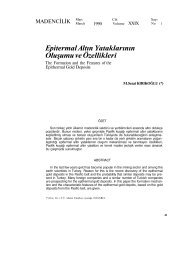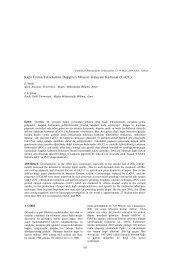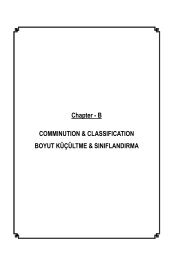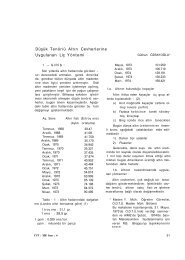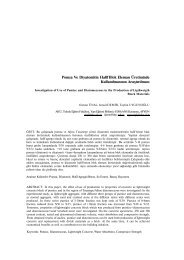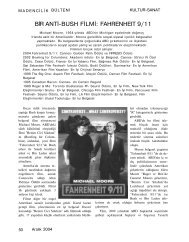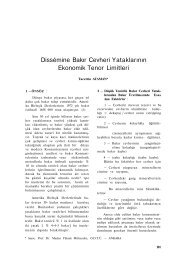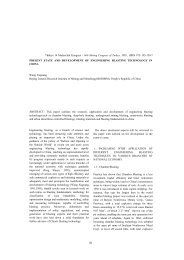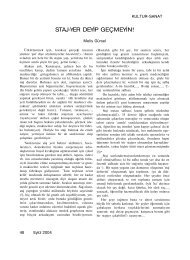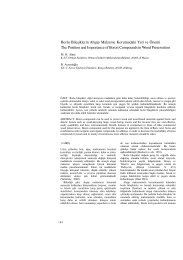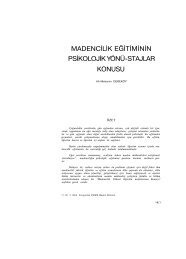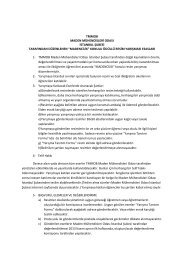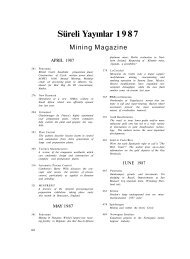A OPEN PIT MINING AÇIK OCAK MADENCİLİĞİ
A OPEN PIT MINING AÇIK OCAK MADENCİLİĞİ
A OPEN PIT MINING AÇIK OCAK MADENCİLİĞİ
Create successful ePaper yourself
Turn your PDF publications into a flip-book with our unique Google optimized e-Paper software.
The limestone was extracted at Gura Vaii,<br />
in Neolithic times. Sand and gravel<br />
exploitation was at Ghioroc.<br />
Certainly, surface mining (in primitive<br />
manner) was practiced in more numerous,<br />
but unknown today sites [Marinescu et<br />
Bogatu, 2005], especially firestone and<br />
quartzite, on Dârjovului Valley, Oltului<br />
Valley, Dâmbovnicului Valley, Lupului<br />
Valley, Prutului Valley.<br />
2.2 Mining Surface in the Antiquity<br />
In the Antique times, on present Romanian<br />
Territory was existed two state entities:<br />
Dacian Kingdom and Roman Empire.<br />
2.2.1 Surface Mining in Dacian period<br />
Although the Dacian state was very large<br />
and well developed, it is known a very small<br />
number of certain surface exploitation: 7.<br />
The andesite was exploited at Uroi Hill<br />
(Simeria city) and Pietroasa Hill (Deva).<br />
With andesite from Pietroasa Hill was<br />
constructed the well known sanctuaries from<br />
the Sarmizegetusa Regia (Gradistea Muncel<br />
today) chapital [Boroneant, 2000].<br />
The limestone surface mining is known in<br />
Magura Hill (on Streiului Valley), near<br />
Calan city and Ardeu (past quarry, near a<br />
Dacian stronghold partially destroyed of a<br />
modern quarry. The sand was extracted at<br />
Ghenetea. From river sands, in indeterminate<br />
points was extracted gold of very good<br />
quality [Marinescu et Bogatu, 2005].<br />
At Bajan Hill (Deva) and Gradistea point<br />
(Santa Maria de Piatra, near Calan) the<br />
archaeologists had indicated two<br />
indeterminate rocks quarries from Dacian<br />
period but exploited and in Roman period<br />
[Boroneant, 2000]. Many Dacian surface<br />
mining had disappeared because the<br />
exploitation had continued in Roman times.<br />
2.2.2 Surface mining in Roman period<br />
The culmination (surface exploitation<br />
number and exploited mineral substances<br />
number) of surface mining in old times was<br />
realised in Roman period. The number of<br />
identified quarries and open pits is 53.<br />
The limestone was exploited in 17<br />
quarries: Magura Hill (Calan), Carpinis,<br />
Geoagiu, Pesteana, Strei (Calan), Valea<br />
Sangiorgiului (Calan), Ampoita, Ighiu,<br />
Albesti, Iablanita, Ruschita, Rusca Montana,<br />
Bahna, Gura Vaii I, Gura Vaii II,<br />
Varciorova, Dinogetia (Garvan).<br />
The marble big quantities was extracted at<br />
Paraului Vally (Cristur), Ruschita and Rusca<br />
Montana (possible and Bucova). Three<br />
andesite quarries are known at Petris-Uroi<br />
(Simeria city), Pietroasa Hill and Pietroasa 2<br />
(the both near Deva city).<br />
The andesite from Petris-Uroi was used<br />
for builds and Ulpia Traiana Sarmizegetusa,<br />
Micia and other roman localities [Boroneant,<br />
2000]. The sandstone was exploited at<br />
Petnic, Rusca Montana, Verendin; dacite at<br />
Creaca Ticlar and travertine at Breznita. Of<br />
course, the sand and gravel was extracted in<br />
many places but is known only Ghioroc open<br />
pit. The Romans had exploited iron ore in<br />
many Dacian mines. The places of surface<br />
mining (was and underground exploitations)<br />
are unknown today, except Teliucu Inferior.<br />
The gold was extracted in some quarries:<br />
–<br />
C . The Romans had obtaining<br />
gold, more pure and with more small costs,<br />
from alluviums in non-identified places on<br />
the rivers (and their affluents): Aries, Mures,<br />
Crisul Alb, Jiu, Olt, Caras, Nera [Marinescu<br />
et Bogatu, 2005]. From this period, the<br />
archaeologists indicated many indeterminate<br />
rocks quarries.<br />
2.3 Mining Surface in the Middle Ages<br />
After the intense mineral substances<br />
exploitation in Roman period, in the first<br />
part of Medium Ages (migratory peoples<br />
period) was not existed a strog state and<br />
identified surface mining was at very low<br />
level. In the second part, the exploitation<br />
intensity will grow. In many Roman quarries<br />
the mineral substances exploitation had<br />
remained.<br />
The limestone was exploited in the<br />
quarries Ardeu, Ruschita, Rusca Montana,<br />
Malu Rosu, Jucu de Sus, Podeni, Sandulesti<br />
Nord, Gura Vaii, Ogradena Veche,<br />
196



